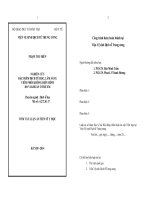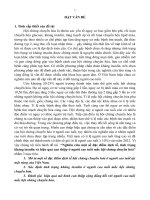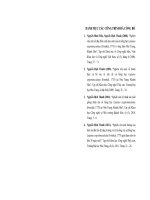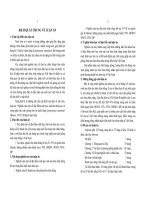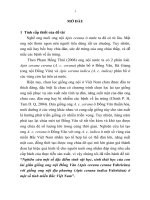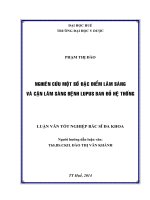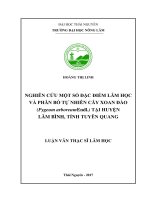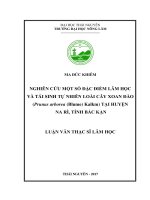Luận án nghiên cứu một số đặc điểm lâm sàng, cận lâm sàng và nồng độ nt probnp với tiên lượng tử vong sau đột quỵ não
Bạn đang xem bản rút gọn của tài liệu. Xem và tải ngay bản đầy đủ của tài liệu tại đây (254.61 KB, 27 trang )
MINISTRY OF EDUCATION & TRAINING
MINISTRY OF DEFENSE
CLINICAL MEDICAL SCIENCE RESEARCH INSTITUTE 108
HOANG DINH TUAN
A RESEARCH ON RELATION BETWEEN CLINICAL
PARACLINICAL CHARACTERISTICS AND NT-proBNP LEVEL
WITH DEATH PROGNOSTIC AFTER STROKE
Major: Neurology
Code number: 62720147
SUMMARY OF MEDICAL THESIS
HANOI – 2022
THE STUDY WAS CONDUCTED AT IN INSTITUTE OF
CLINICAL MEDICAL SCIENCE RESEARCH INSTITUTE 108
Instructors:
1. Assoc Prof Nguyen Huy Ngoc
2. PHD. Nguyen Hong Quan
Reviewer:
1. Assoc Prof. Dr Mai Duy Ton
2. Assoc Prof. Dr Nguyen Hoang Ngoc
The thesis will be defended in front of Institute Council, Institute of
Clinical Medicine and Pharmaceutical Sciences 108.
At
Date
2022
The thesis can be accessed at:
1. Vietnam National Library
2. The Library of Institute of Clinical Medicine and
Pharmaceutical Sciences 108
1
INTRODUCTION
Cerebral Stroke, the second leading cause of death after
cardiovascular disease, has been a topical issue in developing
countries. It is the leading cause of neurological diseases, which
often leaves physically and mentally severe sequelae for the patient,
and brings a heavy burden to the family and society. The disease is
increasing and happens in younger adults, especially in developing
countries.
In the past decades, there have been many advances in the
diagnosis, emergency care, treatment, prognosis and prevention of
stroke, especially the application of new treatment methods such as:
thrombolysis, thrombectomy, endovascular intervention, etc, which
significantly reduce the mortality and disability rate after stroke
attack.
However, the study aims to provide predictive models of
mortality after stroke, including clinical and paraclinical factors,
treatment measures etc, to predict neurological recovery outcomes
and motarlity prognosis remains difficult.
In the world, there are many studies showing that NT-proBNP
is a valuable independent factor in the prognosis of severity as well
as mortality after stroke. In Vietnam, there are no studies on the
relationship between NT-proBNP concentrations with stroke
mortality. With the aim of understanding the role of this biomarker in
the prognosis of mortality after stroke, we conducted this study with
the following two subjectives:
1. Research on some clinical, paraclinical and NT-proBNP
concentration in stroke patients.
2. Clarify the roles of NT-proBNP concentration and some
clinical and paraclinical factors in the prognosis of motarlity after
stroke.
2
CHAPTER 1
OVERVIEW
1.1 Cerebral stroke
1.1.1 Summary of cerebral circulation anatomy and physiology
The brain is an organ with high metabolic needs, but has no
energy reserves, so it requires a large and constant circulation. The
brain accounts for only 2% of body weight but requires 15% of
cardiac supply and 20% of total oxygen consumption in the body.
The brain is supplied with blood by the internal carotid and vertebral
arteries. These two arterial systems are connected through the circle
of Willis and perfuse different regions of the brain.
1.1.2 Definition of cerebral stroke
The World Health Organization (WHO) defined stroke as rapidly
developed clinical signs of focal (or global) disturbance of cerebral
function, lasting more than 24 hours or leading to death, with no apparent
cause other than of vascular origin. The focal neurological symptoms
were consistent with the brain region due to the distribution of damaged
arteries without traumatic causes.
1.1.3. Ischemic Stroke
1.1.4 Hemorrhagic stroke
1.1.5 Risk factors for cerebral stroke
1.1.5.1. Unchangable risk factors: Age, sex...
1.1.5.2. Changable risk factors
- Hypertension, Dyslipidemia, Obesity, Diabetes...
1.1.6. Clinical and paraclinical symptoms
1.1.6.1 Common clinical features of stroke
* The disease usually has a sudden onset, depending on the
affected brain area. There will be focal neurological symptoms such
as Sensory symptoms, Motor symptoms, Cranial nerve paralysis,
language disorders, etc.
1.1.6.2 Clinical symptoms of stroke types
3
1.1.7 Paraclinical symptoms
* Computerized tomography CT.Scan)
* Magnetic resonance imaging (MRI)
* Brain angiography
1.1.8 Prognostic factors for stroke
1.1.8.1 Clinical and paraclinical factors
- Age: Age was both a risk factor and a predictor of mortality.
The older the stroke patient was, the higher the mortality rate and the
more severe the consequence of stroke.
- Consciousness status: The patient's consciousness at
hospital admission was assessed by the Glasgow scale. The lower the
Glasgow score (the deeper the level of coma), the worse the
prognosis and the higher the risk of motarlity. There have been many
studies in Vietnam and the world confirming that Glasgow on
admission has an independent predictive value of mortality after
stroke.
- Severity of nerve damage (NIHSS Score): NIHSS score is
one of the important factors in predicting severity and mortality in
stroke patients.
- Injured brain size: The size of the brain injured or dead is a
very important factor in stroke prognosis.
- Location of the lesion: In general, lesions in the
infratentorial area often have a worse prognosis than ones in the
supratentorial.
- Ventricular hemorrhage: Many studies show that ventricular
hemorrhage is also a serious prognostic factor.
1.1.8.2. Factors associated with disease progression
The severity of injured brain cells might got worse within 48
hours of onset and was associated with a poor prognosis if the status
was left untreated. Some causes were thought to be an increase in the
4
size of the hematoma, hemorrhagic infarction, cerebral edema, or
dilated ventricles.
1.1.8.3. Comorbidities
Stroke patients with comorbidities, especially severe chronic
diseases, will have the disease more severe, difficult to treat, often
longer hospital stays, and especially a higher mortality rate.
1.1.8.4 Biomarkers in stroke prognosis
In addition to the prognostic factors mentioned above,
biomarkers have been studied and applied in the diagnosis and
prognosis of stroke patients such as (MMP)-9, S100β, Lp-PLA2,
Protein C, copeptin, BNP and NT-proNBP, etc.
1.1.8.5. Factors associated with intervention
1.2. NT-proBNP
1.2.1 Overview
1.2.2. Molecular structure and biological effects of BNP and NTproBNP
1.2.3. Release of BNP and NT-proBNP
NT-proBNP is secreted 70% from the ventricular myocytes
and a small amount from the atrial ones. In addition, NT-proBNP is
also secreted from the brain, lungs, kidneys, aorta, and adrenal
glands, at lower concentrations than from the atria. The release of
serum NT-proBNP concentration is regulated by both left ventricular
pressure and volume.
1.2.4. Clearance of BNP and NT-proBNP
1.2.5. Normal serum NT-proBNP value
1.2.6. Factors affecting secretion of BNP and NT-proBNP
Many studies demonstrate that NT-proBNP levels are
negatively correlated with left ventricular blood ejection and
positively correlated with left ventricular muscle mass. In addition,
other factors related to serum NT-proBNP levels include age, gender,
and obesity, etc.
5
1.2.7. Roles of NT-proBNP in cardiovascular diseases and stroke
1.2.7.1. For cardiovascular diseases
1.2.7.2. For Stroke
NT-proBNP levels are often higher than normal in both
ischemic and hemorrhagic stroke patients.
The increased level of this biomarker is related to the extent of
damage, and the area of the lesion. The level often gets higher in the
ischemic stroke group, especially stroke of cardiac origin.
Many studies demonstrate that the increase of this biomarker
is an independent predictor of mortality after stroke.
Determine the cardiovascular causes of ischemic stroke.
Prediction of development of atrial fibrillation after hospitalization
and risk stratification.
BNP and NT-proBNP levels may also be used to predict
second stroke recurrence, and stroke after TIA.
One of the reasons thought to increase BNP levels in stroke
patients is cardiac dysfunction. This includes adaptive vasodilatation
during cerebral infarction or activation of the sympathetic nervous
system leading to increased arterial pressure and higher left
ventricular wall tension. Stroke is an acute stress response involving
a neuronal and systemic inflammatory response that can increase
BNP, NT-proBNP levels. The level increases due to the activation of
the hypothalamic-pituitary-adrenal axis in ischemic stroke. It is also
hypothesized that it may be due to brain damage that increases the
biomarker secretion.
1.2.8. Some studies on the association of NT-proBNP and stroke
- Teresa García et al analyzed a meta-study including 3498
stroke patients from 16 studies to investigate the association between
BNP levels and mortality after stroke. The authors concluded that
BNP/NT-proBNP played a role as an independent prognostic factor
of death after stroke.
6
- Author Joan Montaner in a study used the two biomarkers,
BNP and D-dimer to diagnose embolic stroke of cardiac origin. The
author concluded that BNP and D-dimer climbed up high in the
group of embolic stroke of cardiac origin and the author also
recorded a high positive diagnostic value when combining both
factors with sensitivity and specificity of 66.5% and 91.3%,
respectively.
- To evaluate the role of NT-proBNP and NHISS score in
ischemic stroke, Xing Yong Chen et al studied 122 ischemic stroke
patients and found that NT-proBNP level > 1,583.50 pg and NIHSS
score > 12.5 were independent factors associated with hospital
mortality.
- Kensaku Shibazaki et al studied 335 patients with acute
ischemic stroke admitted to hospitals within 24 hours of onset: After
multivariate logistic regression analysis, the author concluded that
NIHSS score > 13 and plasma BNP levels >240 pg/mL were two
independent factors associated with in-hospital mortality.
- Gregorio T. et al studied 201 patients with cerebral
hemorrhage, the research team concluded: The concentration of NTproBNP at admission time was independently related to the size of
the hematoma. NT-proBNP was an independent predictor of disease
severity in patients with cerebral hemorrhage.
- To evaluate the role of NT-proBNP in predicting stroke risk
after TIA, Rodríguez-Castro E and colleagues conducted a study on
381 patients with TIA. The author concluded, “early determination
of NT-proBNP levels is a simple and very useful alternative for
predicting and forecasting stroke occurring after TIA.
- Hoang Khanh and Tran Thi Phuoc Yen in a study in 2011
summarize that the mean NT-proBNP concentration increased
significantly compared with the control group in both ischemic and
hemorrhage stroke; the mean serum NT-proBNP concentration went
7
up to the highest in the group of patients with NIHSS score > 20
while Huynh Thi Thanh Thuy and Nguyen Thi Minh Duc concluded
that the concentration of NT-proBNP increased in both ischemic and
hemorrhage groups. There is a positive relationship between NTproBNP concentration and severity of nerve damage with NIHSS >
20 points.
CHAPTER 2
RESEARCH SUBJECTS AND METHODS
2.1. Research subjects
300 patients diagnosed with cerebral stroke, treated at the Acute
Stroke Unit, Stroke Center, Phu Tho Provincial General Hospital from
October 2015 to August 2019.
2.1.1. Inclusion criteria
- Age: Patients over 18 years old
- Have diagnosis of acute cerebral stroke based on clinical and
laboratory criteria
- Hospitalization within 72 hours of stroke onset.
2.1.2. Exclusion criteria
- Patients with a brain tumor, traumatic brain injury,
encephalitis, infection, immune diseases.
- Patients with a transient ischemic attack (TIA).
- Patients with a history of cardiovascular diseases such as
heart failure, valvular disease, atrial fibrillation, dilated
cardiomyopathy, ischemic heart disease, and myocardial infarction.
- Patients with serious diseases: liver failure, severe kidney
failure
- Patients with ischemic stroke have been successfully treated
with mechanical thrombectomy.
- Patients who died after 30 days of hospitalization
- Patients whose death did not cause by a stroke
8
- Pregnant women
- Patients who did not agree to participate in the study.
2.2. Research Methods
2.2.1. Research Design
Descriptive prospective study, the study population was
divided into 02 groups: The fatal group and the survival group
(survival) for comparison.
2.2.2. Population size calculation
Z(1-α/2)2p (1-p)
n=
ᴈ2
With:
- P: Estimated stroke mortality rate: P = 0,2
- Z(1-α/2): With confidence 95% = > Z(1-α/2) = 1,96
- ᴈ: Relative error, take 5% = > ᴈ = 0,05
2.2.3. Research design
2.2.3.1 Collect data
All stroke patients admitted to the Stroke Center of Phu Tho
Provincial General Hospital within 72 hours of onset were asked
about their illness, history, and under clinical examination based on a
common medical record. The patients were applied a general,
standard treatment regimen according to the acknowledged
Guideline.
* Variables used in the study:
- Age, sex, pulse, blood pressure, weight at admission.
- Time from onset to initiation of treatment.
- High blood pressure
- History of stroke, hypertension, smoking, drinking alcohol,
- Blood count with 18 indexes, blood biochemical indicators.
- Coagulation tests (PT, APTT, etc.)
- NT-proBNP concentration test:
9
- Chest X-ray with AP/PA and lateral view (pneumonia)
- Electrocardiogram (arrhythmia, atrial fibrillation, etc.)
- Doppler echocardiography or 4D echocardiography(EF, %D)
- CT scan or MRI scan of the brain
* Some equipment used in the study:
+ Automatic hematology testing machine, Cobas e 601 blood
biochemistry analyzer, Blood count testing machine.
+ Hitachi Digital X-ray machine (Japan).
+ SOMATOM sensation computerized tomography scanners (32,
64, or 128 slide scanners), 1.5 Tesla Magnetic Resonance Scanner
+ 4D Siemens Cardiac Ultrasound Transducer Probe (Germany).
+ 3-arm and 6-arm 12-Lead ECG Machines
2..2.3.2 Evaluate the collected database against the following
criteria
- Hypertension: Diagnosis and grading of hypertension based
on JNC VII criteria:
- Dyslipidemia: Based on the recommendations of the
Vietnam Heart Association and NCEP ATPIII (2001)
- Tachycardia, when heart rate > 100ck/min
- Criteria for diagnosis of heart failure: Apply the ESC's
guidelines for diagnosis and treatment of acute and chronic heart
failure in 2021:
- Electrocardiogram: Diagnosis of coronary insufficiency
- Doppler echocardiography: All patients who have heart
diseases detected under ultrasound such as regional movement
disorders, valvular stenosis, open heart valve, and signs of heart
failure, will be excluded from the study group.
- Tachycardia: Normal heart rate is in the range of 60-100
beats/min, heart rate >100CK/min is considered tachycardia.
- Assess the patient's consciousness according to the Glasgow
Scale
10
- Evaluate the size of the blood clot on CT images based on
Broderick's formula: V(cm3) = A.B.C/2
- Diagnosis of massive cerebral infarction when the infarcted
area is > 2/3 of the perfusion area of the middle cerebral artery, and
the volume is > 145ml.
- Assess the severity based on the NIHSS Stroke Scale
- Assess muscle strength: According to the muscle strength
scale of the British Medical Research Council (MRC scale)
- Assess the degree of disability based on the Modified
Rankin Scale
2.2.3.3 Data analysis and evaluation methods
Assess general characteristics of research subjects, assess
the relationship of NT-proBNP with some clinical and
paraclinical characteristics
Divide study subjects into cerebral ischemic and hemorrhage
groups. Then evaluate, compare and find out the characteristics of
some common clinical and paraclinical symptoms of the researched
groups and assess the relationship of NT-proBNP with some clinical
and paraclinical characteristics.
Assess the association of NT-proBNP and some clinical and
paraclinical features with mortality after stroke
Divide study subjects into 2 groups: Fatal and survival, then
use univariate and multivariable Logistic analysis algorithm to find
the relationship between NT-proBNP concentration and some
clinical symptoms, paraclinical with mortality after stroke.
2.2.4. Data processing
- Data were processed using SPSS 20.0 software
- Using statistical algorithms such as compare mean values,
Anova test, univariate and multivariate analysis, etc.
- Using univariate and multivariable binary logistic regression
analysis to identify factors related to severe prognosis and mortality
of ischemic and hemorrhage stroke.
2.2.5. Ethics of research
11
STUDY DIAGRAM
The patient was diagnosed with cerebral stroke
and met inclusion criteria
Ischemic Stroke
Hemorrhage
Stroke
1. Evaluate and comment on some general characteristics, clinical
and subclinical characteristics such as age, gender, risk factors,
onset symptoms...
2. Analysis to find out the relationship between NT-proBNP
concentration with some clinical and subclinical characteristics
Group II:Nonfatal
Group I: Fatal
Assess the association of NT-proBNP and clinical, paraclinical
factors with mortality after stroke by univariate logistic analysis
After univariate Logistic analysis, insert factors related to mortality after
stroke into multivariable Logistic analysis to identify factors which were
independently associated with mortality after stroke.
CONCLUSION
12
CHAPTER 3
RESEARCH RESULTS
3.1 Some clinical, paraclinical, and NT-proBNP levels in stroke
patients
Stroke patients were mainly over 60 years old, and the average
age of the study group was 70,2 ± 13,2 years old. The current rate of
stroke in Men (62,3%) was higher than in Women (37,7%). Ischemic
stroke accounted for a higher rate (63,3%) than hemorrhagic stroke
(36,7%). Hemiplegia was the most common onset symptom (92%),
followed by dysphasia/aphasia (72,3%). The most common risk
factor was hypertension, accounting for 79,3%, followed by
dyslipidemia. The most common clinical symptoms were:
Hemiplegia (95,3%); Headache (87,7%) 7th Nerve Palsy (68%).
There were 67 (22,3%) patients with respiratory failure requiring
ventilation.
The mortality rate in the group with hemorrhage stroke
(28,1%) was higher than that of the group with ischemic stroke
(9,5%), (p < 0,001). The overall mortality rate of the study patients
was 16,3%.
3.1.6 The relationship between NT-proBNP levels and some
clinical and paraclinical factors in cerebral stroke
Table 3. 14 The relation between NT-proBNP levels with
types of stroke
Number of
p
Stroke type
NT-proBNP
Patients
Hemorrhage
110
422,63 ± 567,53
0,932
Ischemic
190
429,87 ± 780,97
Sum
types
300
422,21 ± 709,20
There was no difference in NT-proBNP levels between stroke
13
Table 3. 15 The relation between NT-proBNP levels and age
and gender
Characteristics
Pulse (n)
NT-proBNP
p
< 60 years old
67
353,23 ± 605,01
0,334
≥ 60 years old
233
448,47 ± 736,24
Man
187
371,93 ± 623.03
Gender
0,082
Woman
113
518,70 ± 827,37
There was no statistically significant difference between NTproBNP levels in women younger than 60, and men older than 60.
Table 3. 17 The relation between NT-proBNP levels with
clinical symptoms
Age
Characteristics
15 score
Glasgow
NIHSS
Number of
patients (n)
NT-proBNP
89
184,59 ± 277,29
187
527,34 ± 837,47
≤ 8 score
24
546,78 ±498,28
1 - 6 score
101
169,19 ± 251,02
7 - 15 score
119
449,91 ± 831,51
> 15 score
80
719,19 ±786,68
104
209,28 ± 303,30
143
507,96 ± 833,97
53
636,98 ± 807,95
fast
46
563,06 ± 686,20
Normal
254
402,61 ± 711,82
Yes
81
637,71 ± 401,49
From 9 - 14
score
p
0,001
<0,001
Mild to
moderate
palsy
Palsy level
severe palsy
Total
paralysis
pulse
pneumonia
< 0,001
0,158
0,002
14
Ventilation
No
219
349,36 ± 519,61
Yes
67
800,78±1106,98
No
233
319,79 ± 497,71
< 0,001
NT-proBNP levels have relation with the severity of stroke.
The more severe the stroke, the higher NT-proBNP levels
Table 3.18 The relation between NT-proBNP with some
paraclinical factors
Number
Characteristics
of Patients
NT-proBNP
p
(n)
3
< 30 cm
83
394,34 ± 592,70
Size of
0,362
3
Clotting
≥ 30 cm
27
509,59 ± 481,60
Area of
Wide area
21
1144,86±1646,99
ischemic
0,001
lesion
thergroup
169
341,02 ± 529,80
NT-proBNP levels in patients with major ischemic stroke were
higher than those of the rest group, and the difference was stastically
significant with p <0,001.
3.2. The relation between NT-proBNP levels and some clinical
and paraclinical factors with mortality after stroke
3.2.1 Comparison of NT-proBNP levels between 2 groups, fatal
and survival
Table 3. 19 NT-proBNP levels between the two groups of
fatal and survival patients
Type
Number of
Outcome
NT-proBNP
p
patients (n)
Hemorrhage
Ischemic
Survival
Fatal
Survival
Fatal
79
31
172
18
300,59 ± 391,43
< 0,001
733,64 ± 795,43
316,65± 512,79
< 0,001
1511,74±1663,37
15
Survival
251
311,59± 477,20
< 0,001
Fatal
49
1019,47±1232,47
The NT-proBNP level in the fatal group was higher than that
of the living group. The difference was significant when analyzing
the general group as well as when analyzing separately ischemic and
hemorrhage groups:
Table 3. 20 The relation between NT-proBNP levels and
outcomes after stroke by different groups
Sum
Subjects (n)
Fatal
Survival
p
1236,95±1341,53
318,38±471,62
<0,001
< 60 (67)
570,94 ±838,30
284,98±520,43
0,099
Men (187)
931,33±1074,13
285,60±469,42
<0,001
Women (113)
1111,29±1396,03
358,90±490,18
<0,001
Hypert
Yes (238)
977,21±1286,78
309,76±483,73
0,001
ension
No (62)
1207,29±996,64
318,42±456,35
<0,001
Diabett
Yes (44)
1875,68±2741,87
168,88±260,25
<0,001
es
No (256)
922,18±949,38
337,84±503,15
<0,001
Dyslipi
demia
Yes (193)
1138,33±1565,72
301,37±521,58
<0,001
No (107)
895,66±762,00
332,27±373,60
<0,001
> 15 (80)
797,01±822,03
648,78±756,28
0,430
≤15point(120)
1787,96±1988,28
243,83±365,22
<0,001
Glasgo
≤ 8 point (24)
511,03±501,25
618,29±518,28
0,630
w
> 8 point(276)
1266,00±1430,13
301,49±473,57
<0,001
≥ 60 (233)
Age
Gender
NIHSS
When analyzing by different subgroups (age, gender,
hypertension, dyslipidemia...) the NT-proBNP levels in the fatal
group were higher than that in the survival group, and the difference
was statistically significant.
16
3.2.2. Determination of cut-off point of NT-proBNP concentration
value in predicting mortality after stroke (ROC curve analysis and
determination of NT-proBNP concentration cut-off point)
3.2.2.1 Prognostic value of NT-proBNP levels with mortality after
hemorrhage in patients with dyslipidemia
Table 3. 1 ROC curve of NT-proBNP levels in the prognosis of death
after cerebral hemorrhage stroke
The serum NT-proBNP levels in the prognosis of death in
hemorrhage patients was moderate with the area under the curve
(AUC) was 0.717
Table 3. 22 Determination of the NT-proBNP cut-off point in the
prognosis of mortality after hemorrhagic stroke
NT-proBNP
Sensitivity
Specificity
J Index
2,50
1,000
0,013
0,013
…
…
…
…
184,60
187,40
196,90
205,50
206,90
…
0,806
0,806
0,806
0,774
0,742
…
0,582
0,595
0,608
0,608
0,608
…
0,389
0,401
0,414
0,382
0,350
…
3,421,00
0,000
1,000
0
17
The cut-off point of the NT-proBNP levels between the survival group
and the fatal group was 196,9 pmol/L. This cutoff corresponded to the
most optimal sensitivity and specificity, 80,6% and 60,8%, respectively.
3.2.2.2 Prognostic value of NT-proBNP levels with mortality after
ischemic stroke
Chart 3. 2 ROC curve of NT-proBNP values in predicting
mortality in patients with ischemic stroke
The value of serum NT-proBNP levels in the prognosis of
death in patients with cerebral ischemic stroke is good with the AUC
of 0,851.
Table 3. 24 Determination of the cut-off point of NT-proBNP in
the prognosis of mortality after ischemic stroke
NT-proBNP
Sensitivity
Specificity
J Index
4,0
…
1,000
…
0,000
….
0,000
….
371,75
379,10
384,10
680,15
….
6752,00
0,833
0,833
0,833
0,722
….
0,000
0,750
0,756
0,762
0,878
…
1,000
0,583
0,589
0,595
0,600
….
0
18
The cut-off point of the NT-proBNP value between the
survival group and the fatal group was 384.1 pmol/L. This cut-off
point corresponded to the optimal sensitivity and specificity of
83,3% and 76,2%, respectively.
3.2.2.3 Prognostic value of NT-proBNP levels with death after
stroke
Chart 3. 3 ROC curve of NT-proBNP value in mortality
prognostics
The value of plasma NT-proBNP levels in the mortality
prognosis of this study was average with the AUC of 0.766.
Bảng 3. 26 Determination of the NT-proBNP cut-off point in the
prognosis of death after stroke (general group)
NT-proBNP
Sensitivity
Specificity
J index
2,50
1,000
0,004
0,004
…
…
…
…
293,40
0,714
0,705
0,419
296,50
0,694
0,705
0,399
301,65
0,694
0,709
0,403
...
...
...
...
6752,00
0,000
1,000
0
